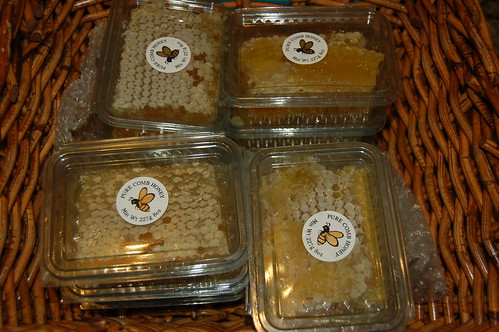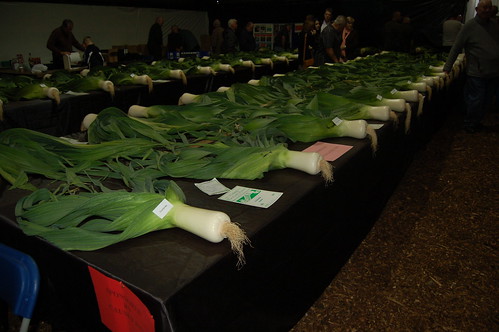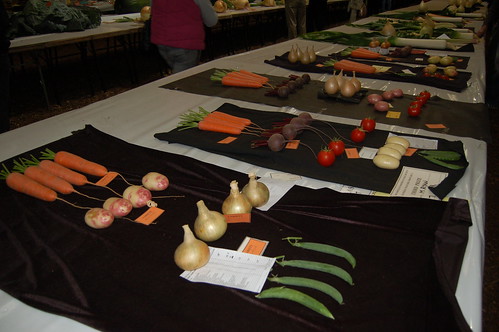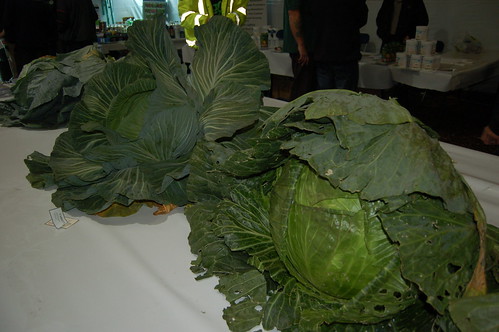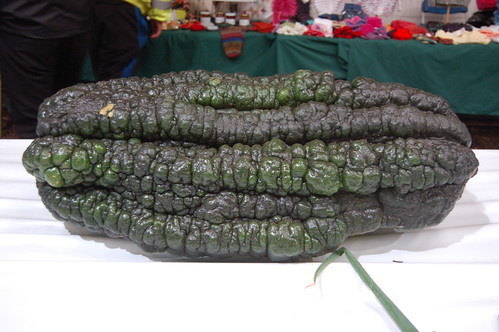We are on the final day of 2012, a year I do not want to repeat. The weather has knocked back so many of our plans and wrecked many of our crops. The bees produced only a minimal amount of honey. The wild apples and sloes never appeared. But it's not all been bad news. We have expanded the number of hens we have. The ducks arrived in September. In October we bought our first pig, a Tamworth.
Our poultry and pig ventures bring me to my Christmas presents. I hate the idea of people buying presents for others that are not needed or not wanted. TV advertising in the run up to Christmas is packed full of commercials for rubbish for people to buy who can't think of what to get others. I always insist on people getting me practical presents that I need. So this year I got B&Q vouchers, oven gloves, an apron, a sausage making machine, an incubator and a heater for the chicks once they have hatched.
We have a freezer full of sausage meat so we'll be having a go at sausage-making shortly. We have a reasonable amount of game as well so we'll have a go at making game sausages as well.
The plan for the incubator is to use it for quail and duck eggs. There may be some turkeys as well. However, we are looking for a supply of rare breed hen eggs to help with efforts to protect breeds that could disappear.
We grow our own food in a suburban village in the North East of England. Follow us as we keep up the battle to be self-sufficient.
Monday 31 December 2012
Friday 21 December 2012
Fruit Liqueurs
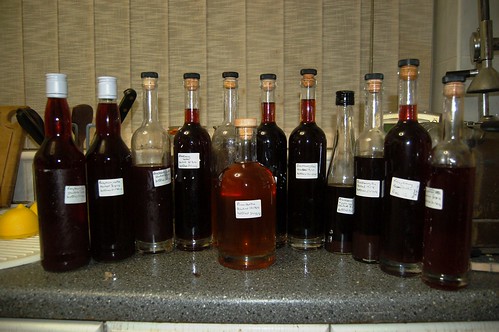
These are the fruit liqueurs I bottled up this evening - 7 full and 5 half bottles. All but 2 were initially made last year and left to brew. I don't normally let them stand for so long before bottling them. The normal time is 3 months but somehow they were left on the shelf whilst I did other things.
Just to reassure you, we will not be consuming all the bottles over the Christmas period. This collection should last us for the whole of the coming year, even with some being consumed by friends who drink more than me or given as presents. My weekly tipple is one glass on a Saturday evening and a glass of wine with the Saturday and Sunday dinners. (A bit more when on holiday or in London.) Everything in moderation.
The collection of liqueurs includes raspberry gin, raspberry vodka, blackberry vodka, plum vodka, blackberry and apple gin and blackberry gin. The pickled fruit has been saved and I'm looking for Georgian trifle recipes in which the fruit can be used.
More trade

I have previously mentioned the importance of trading or swapping in the world of self-sufficiency. The rabbit and 2 pheasants above, plus a further pheasant delivered to us a couple of weeks ago, cost us a joint of pork from our tamworth pig. The pheasants will form part of our Christmas dinner.
Egg production has picked up slightly but as I've been away for a couple of weeks, we have a bit of an egg mountain. So trade in eggs has picked up. This morning, I swapped a dozen eggs for a large bag of onions and leeks. A dozen eggs is about to head over to another allotmenteer's house and a further dozen will be going shortly to a friend in exchange for a bag of kale.
Finally, it's 21st December. Happy Winter Solstice. From tomorrow the days will be getting longer, though it will be ages before we notice the difference. I posted something about this on Facebook earlier today and someone posted a comment that as of tomorrow, we will have 14 minutes more daylight this coming week. That will make all the difference up here in the North East of England!
Sean's Allotment Garden
My friend Sean Cameron, who was producer of the Horticultural Channel (we had a series of 6 programmes on a Sky satellite channel in 2011), is launching a new allotment series on YouTube in January.
Sean's allotment is in South East London and I was last there in October. We also filmed a few of the programmes for the Horticultural Channel there as well.
I'll be posting up Sean's videos in the New Year but the above is the trailer for the series.
Sean's allotment is in South East London and I was last there in October. We also filmed a few of the programmes for the Horticultural Channel there as well.
I'll be posting up Sean's videos in the New Year but the above is the trailer for the series.
Monday 3 December 2012
Snow fall and baffled hens
We had a modest amount of snow overnight, about 2cm. When I let the hens out each morning, they normally charge out of the henhouses and head towards the top of the chicken run where I feed them. Today however, they stepped out and looked around in a state of confusion. Some of them stayed in the henhouse for a few minutes before bucking up the courage to walk out into the alien landscape. Others wandered around looking at things suspiciously. Once they realised the snow was not a threat to them, they shrugged it off, ate their wheat and pellets and headed off for a day in the snow. Meanwhile, the ducks were loving it.
Wednesday 28 November 2012
Between storms
It seems the incredibly wet weather of the summer is not letting up as we approach the winter. I was hoping conditions were improving at the start of November. We had about 10 days without rain, long enough for the water butts to be close to empty. On a couple of mornings we even took water over to the allotment to ensure we had sufficient for the hens and ducks. And then the storms began again. We now have a huge amount of mud on the allotment and a stream running into one side of the duck pond and out the other side. This however is not as bad as it seems. The ducks had made quite a mess of the pond and we were planning to pump out the water and clean it out. The weather has flushed it out for us. Whilst the ducks are having a great time in the mud and damp conditions, the hens are not feeling so happy about it.
Attempts to plant anything at the moment are futile. We got our winter cabbages, some chard and half our onions planted towards the end of the dry spell this month. The other half of the onions are still waiting to go in. We are expecting dryer weather for the rest of this week but the ground is so wet that I doubt we will get them planted soon.
Attempts to plant anything at the moment are futile. We got our winter cabbages, some chard and half our onions planted towards the end of the dry spell this month. The other half of the onions are still waiting to go in. We are expecting dryer weather for the rest of this week but the ground is so wet that I doubt we will get them planted soon.
Wednesday 21 November 2012
Sweet mince
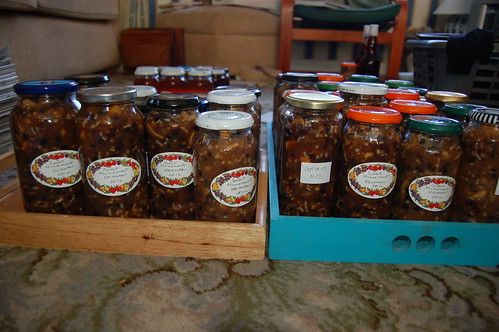
Autumn arrives and so does the need to make sweet mince. I have previously made a video about making sweet mince so I'm not going to talk about the whole of the recipe. I will however mention in passing the gin and vodka pickled fruit left over from making fruit liqueurs. I save it up and add it to the sweet mince. I am sometimes left with old jams and marmalades and jellies that have not set well (or at all!) so rather than waste them, they also find their way into the sweet mince as well.
As a result, I now have 37 jars of sweet mince. I will be making lots of pies and doing lots of swaps shortly.
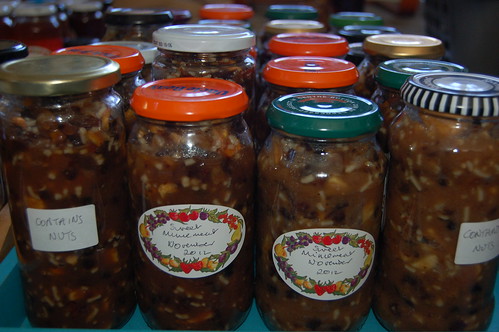
Making beetroot relish
Friday 16 November 2012
Another stash of hidden eggs
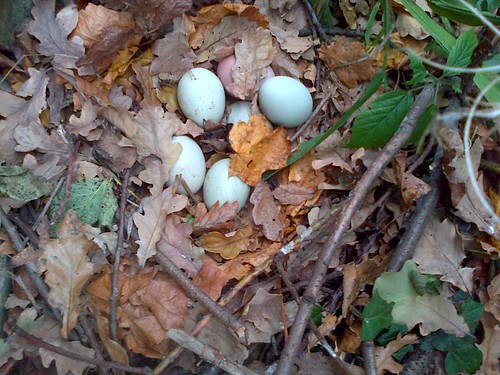
The number of eggs our hens have been producing recently has dropped. Some of this is down to the fact some are moulting but it is not enough to explain the full drop. For some days, there have been no green eggs, laid by my columbines. Today, when I opened up the henhouses, I spotted one of the columbines head to the tool cabinet on the allotment. I had a look behind it and there were 5 columbine eggs and one laid by one of our ambers. So that's that problem solved.
Meanwhile, I rather like the photo below I took this morning. Some of the hens are in the shelter we built for them earlier this year. It is meant to keep them dry when it rains - and we have had a vast amount of rain this year. Yet, for the past few weeks, we have experienced up here a relatively dry fortnight. The ground has dried out and the hens don't need to shelter from rain. Oddly, now is the time they decide to use it!

Thursday 15 November 2012
Victorian jam pan
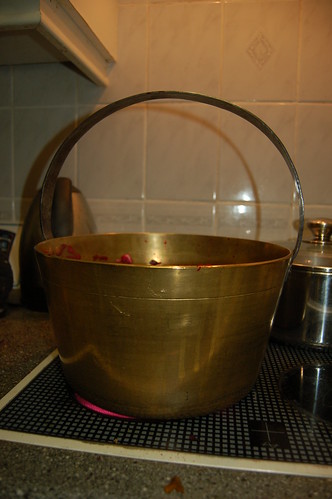
A number of readers and viewers of my videos have commented recently to me about my jam pan. So why should a pan be such a point of interest for a conversation? Well, it's because it is made of aluminium and some people have raised issues about the affect on health of this metal. So, in the pursuit of a healthy lifestyle, I have borrowed from Dad the jam pan with which I was taught to make jam. It is made of brass and is Victorian. My great grandmother Jessie Wallace was the first to use it over 120 years ago and it's been in the family every since. Tonight I used it to make beetroot relish (more on that later).
Monday 12 November 2012
Ash die-back disease
Another crisis looks set to ravish our woodlands. The UK media has been reporting extensively on ash die-back disease having been found here. Ash trees at a number of sites in the UK have been found to be suffering from the disease caused by a fungal infection (official name Chalara. Fraxinea) which has already struck woodlands in European countries such as Denmark and Poland. There are two possible routes the disease has travelled to arrive in the UK: airborne spores which have been blown across the North Sea and infected trees imported from Europe. Whatever the cause, we now have it here in the UK and we are in a situation in which we will have to manage it, rather than eradicate it.
Approximately one in three trees in UK woodlands is an ash. I have lots of them on the edge of my allotment and the ash keys from the nearby mature trees rain down on us leading to ash tree saplings growing like weeds. We are constantly having to get rid of them. My fear is that that will become a memory as the disease spreads across the UK.
Back in the 1970s we saw the loss of most of our Dutch elms in Britain. Dutch elm disease left its mark everywhere. Millions of trees fell victim. I still remember spotting the elm in the woodland behind our house beginning to suffer from the disease. The Council was called, they came out and one day I got back from school and found the wrong tree had been cut down. Sometime later, the correct tree was felled and burnt.
I never thought I would see the day when another of our common woodland species would be threatened with near total loss.
Judging from the messages, posts and emails I receive from readers of this blog, I know many of you live in central and eastern Europe. If your area has suffered from ash die-back, post up a comment to tell me what happened and what the effects were. You can also email me – jonathanwallace@compuserve.com.
Approximately one in three trees in UK woodlands is an ash. I have lots of them on the edge of my allotment and the ash keys from the nearby mature trees rain down on us leading to ash tree saplings growing like weeds. We are constantly having to get rid of them. My fear is that that will become a memory as the disease spreads across the UK.
Back in the 1970s we saw the loss of most of our Dutch elms in Britain. Dutch elm disease left its mark everywhere. Millions of trees fell victim. I still remember spotting the elm in the woodland behind our house beginning to suffer from the disease. The Council was called, they came out and one day I got back from school and found the wrong tree had been cut down. Sometime later, the correct tree was felled and burnt.
I never thought I would see the day when another of our common woodland species would be threatened with near total loss.
Judging from the messages, posts and emails I receive from readers of this blog, I know many of you live in central and eastern Europe. If your area has suffered from ash die-back, post up a comment to tell me what happened and what the effects were. You can also email me – jonathanwallace@compuserve.com.
Feeding the bees
We fed all 8 of our hives yesterday with fondant. We used something called "Fondabee". Instead of coming in a 12.5kg block that needs to be cut up into smaller chunks, Fondabee comes in 2.5kg blocks, each one ready wrapped. And to add to that, a section of the wrapping can be easily stripped off. This is a considerable improvement on the old system of chopping off a chunk of fondant, putting it into a plastic bag and then ripping open part of the bag to allow the bees to get to the fondant. My guess is that Fondabee has been invented by someone who is a beekeeper.
I have to confess that I am not a fan of the way commercial products are packaged. The packaging is excessive and eats up important resources which then enter our waste stream. Dealing with packaging is one of the biggest headaches for those responsible for disposing of waste. Something I have noticed since we started to go down the road of self-sufficiency is the big reduction in waste we put out for collection. Nevertheless, the way Fondabee is packaged is progress.
We did not do proper inspections of the hives but we got a good impression of their health. 6 of the hives are fine. 2 need to be watched closely. They could be candidates for merging with other hives in the new year.
I have to confess that I am not a fan of the way commercial products are packaged. The packaging is excessive and eats up important resources which then enter our waste stream. Dealing with packaging is one of the biggest headaches for those responsible for disposing of waste. Something I have noticed since we started to go down the road of self-sufficiency is the big reduction in waste we put out for collection. Nevertheless, the way Fondabee is packaged is progress.
We did not do proper inspections of the hives but we got a good impression of their health. 6 of the hives are fine. 2 need to be watched closely. They could be candidates for merging with other hives in the new year.
Wednesday 7 November 2012
Duck scotch eggs

We are now getting two eggs a day from our ducks. So far, I've made a couple of sponge cakes and 6 scotch eggs with them. Today I poached one. The scotch egg recipe is no different to the one I use when making them using hen eggs. I have to confess that the sausage meat we used did not come from our Tamworth pig. One of the reasons for making the scotch eggs was to use up some sausage meat we have bought some time ago and put in the freezer. We wanted it used up before we start making inroads into the significant quantity of Tamworth sausage meat now in our freezer.
Making runner bean chutney
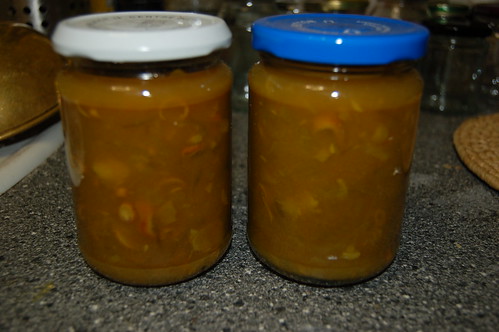
The last of the runner bean crop is now harvested and so we are faced with choices of how to preserve them. We have, in past years, frozen and salted them. This year we have frozen most but put some aside to make runner bean chutney.
Here is the recipe I used over the weekend:
- 1kg sliced runner beans
- 750g chopped onions
- 900ml cider vinegar
- 45g cornflour
- 1 heaped tbsp mustard powder
- 1 level tbsp turmeric
- 700g soft brown sugar
Whilst the simmering is taking place, mix the cornflour, turmeric and mustard with a bit of vinegar to make a paste. Add this to the pan with the onions and runner beans. Pour in the rest of the vinegar and simmer for 10 minutes. Then add the sugar and simmer for a further 15 minutes.
Add to warm sterilised jars.
There are two waste products from this recipe that can be used elsewhere. The water in which the beans were boiled can be saved to make a stock. I've just made bacon and vegetable soup using this stock. And the top and tail of the runner beans, and the stringy edges, all of which are removed before the beans are chopped, can also be used to make stock as well.
In other words, waste nothing.
Sunday 4 November 2012
Tamworth pig update
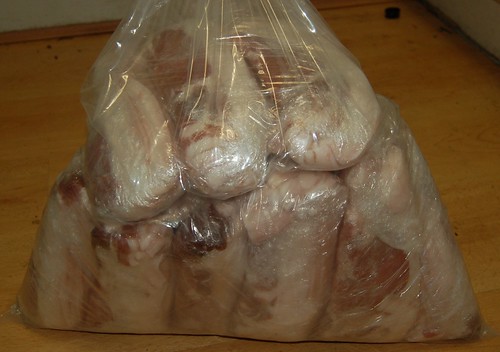
We have now got the bacon back from the butchers from our Tamworth pig. We picked it up yesterday and last night we had our first meal using the bacon - the classic British breakfast meal bacon and eggs though we were having it for our evening dinner. The eggs were our own as well.
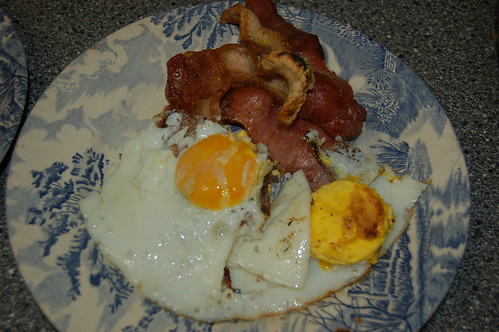
The Tamworth is quite an old breed, predating the modern, commercial breeds and therefore the meat is considered to be much closer to the original forest-dwelling wild swine from which domesticated breeds are descended.

The flavour of the bacon was superb and there was a good layer of rind which grilled to a beautifully crisp texture.
The leg joint we roasted last weekend has now been fully used. The meat left over from the Sunday roast went into a pork and vegetable soup which we consumed through the week. The bone has gone into the freezer and at some point will be used to make more stock.
Alas, our cat has decided not to share our enthusiasm for the Tamworth. We cooked her some lung. She ate half of it and then refused to touch the rest. We tried to give her some more freshly cooked lung but she wasn't having it. What we had cooked for her ended up going into making the stock for the soup. If anyone has any recipes for pig lung, please send them! Pushka is now back on to Whiskas, not exactly part of our plan to become self-sufficient, though she did rather like the bits of the leg joint we gave her!

Friday 2 November 2012
High in a hedge
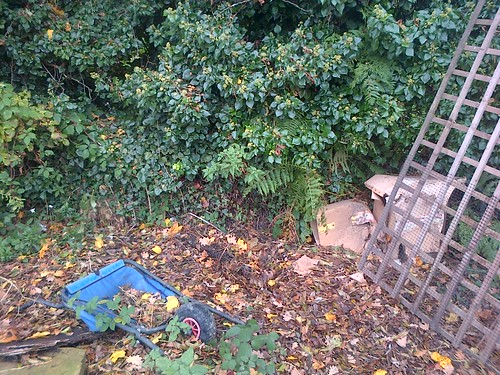
Yesterday I wrote that the productivity of our hens had gone down recently. I put some of this down to hens moulting and the seasons. Well, this morning, I noticed one of my hens emerge from the ivy hedge next to the entrance to the chicken run. Curiosity got the better of me so I took a look at where she had been and found this:
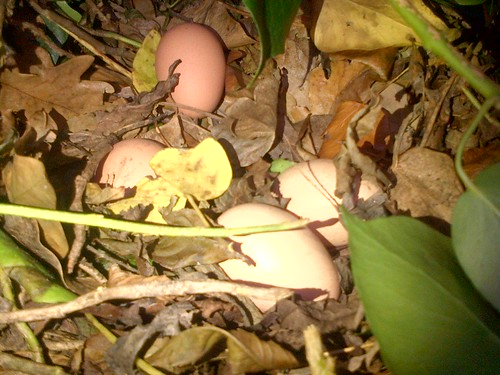
A hens' nest containing 4 eggs. It doesn't explain the whole reason for the drop in egg output and maybe I need to check other hedges, however, it does partly explain why previously it appeared that 14 hens were producing only 7 eggs a day.
Thursday 1 November 2012
A second duck starts laying
About three weeks ago, one of my khaki campbell ducks started laying. Since then she has laid every day except once. Today, the second khaki produced an egg. If she is anything like the other, we will have quite a supply of duck eggs. I used six of the eggs this evening to make scotch eggs. They will do for lunches for the next few days.
The 4 ducklings are growing fast. Actually it's a bit inaccurate to call them ducklings. 3 of them (the aylesbury, runner and magpie) are now fully grown. The 4th (another khaki) is not far behind. As yet, we still don't know what sex they are.
Productivity from the hens however has gone down. We have only 14 now but are averaging only 7 eggs a day. At least two are moulting which partly explains the drop in the number of eggs. The columbines have stopped laying their lovely green eggs. Maybe they are more seasonal in their laying habits.
The 4 ducklings are growing fast. Actually it's a bit inaccurate to call them ducklings. 3 of them (the aylesbury, runner and magpie) are now fully grown. The 4th (another khaki) is not far behind. As yet, we still don't know what sex they are.
Productivity from the hens however has gone down. We have only 14 now but are averaging only 7 eggs a day. At least two are moulting which partly explains the drop in the number of eggs. The columbines have stopped laying their lovely green eggs. Maybe they are more seasonal in their laying habits.
Wednesday 31 October 2012
The honey harvest plummets
The BBC is reporting today that the UK honey harvest this year is 72% down on what would normally be expected (http://www.bbc.co.uk/news/uk-20139062). As a beekeeper myself, this comes as no surprise. Indeed, "I picked a fine time to start beekeeping" would be an appropriate description for me. We got our first hives last year and this year was meant to be our first year of production. Like other beekeepers, the wet and cold spring and summer washed away our plans. We had a tiny honey crop, 3.5kg, from one hive, nothing from the rest. I am hoping that next year will be an improvement but for that we need some decent weather.
The other disappointing issue is that beekeeping is very much a cottage industry. It is based on a large number of people running small honey producing businesses. I am a great believer in self-employment (as well as self-sufficiency!) with people running micro and small businesses that supply goods and services to local markets. It is one of the routes to economic recovery after the disaster of the financial crisis. The weather seems to be doing its best to stop that recovery taking place.
The other disappointing issue is that beekeeping is very much a cottage industry. It is based on a large number of people running small honey producing businesses. I am a great believer in self-employment (as well as self-sufficiency!) with people running micro and small businesses that supply goods and services to local markets. It is one of the routes to economic recovery after the disaster of the financial crisis. The weather seems to be doing its best to stop that recovery taking place.
Sunday 28 October 2012
Roast pork dinner
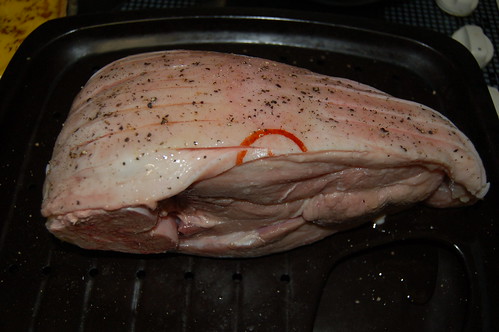
Tonight we had our first joint from our Tamworth pig. A 2kg leg joint and it tasted fantastic. The before and after photos of the joint roasted are above and below. Further down is the meal itself. Everything else on the plate was grown by us or swapped. Coming up shortly is pudding: a custard tart made with lots of our eggs.
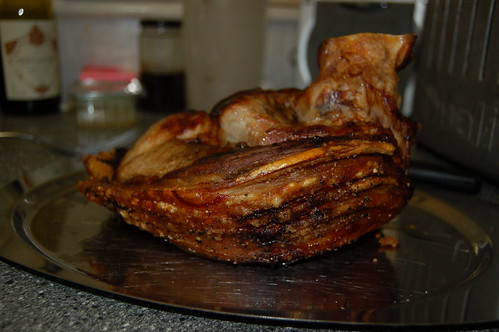
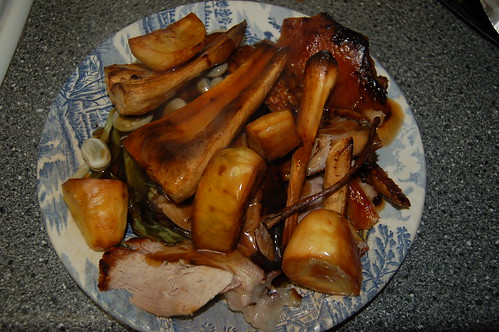
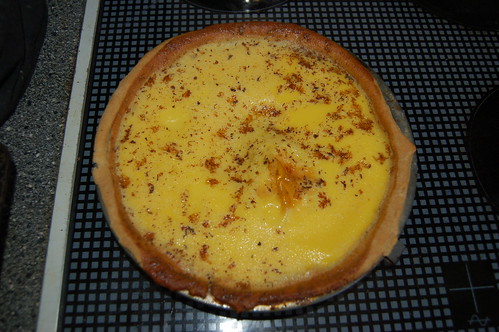
Duck update
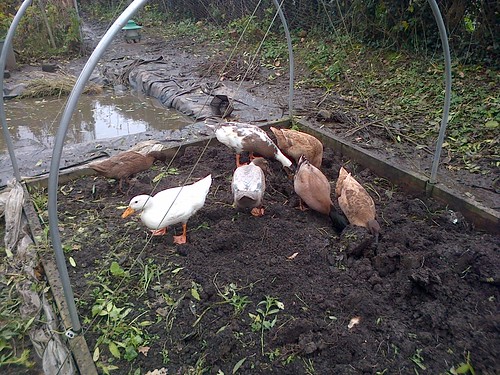
It is now a couple of weeks since we let the ducks go free range. They have taken well to the allotment but unlike the hens, they remain on our allotment rather than wandering off to other people's plots. They stick together as a group of 7 so if one decides to wander off across the allotment, the other 6 will follow. Initially they were very nervous of us, always moving away when we were around. More recently, though still keeping their distance, they haven't headed off in the opposite direction. Today, they even came on to the same bed I was working. I needed to prepared the raised bed to plant some onions. That meant weeding, manuring and digging it over. One duck in particular, the magpie, was quite happy to be at my feet, grabbing what worms that were available.
The ducklings have grown rapidly and all but one (the khaki campbell) are now fully grown. We still have only one bird laying but for the past three weeks she has laid every day except one (yesterday). We are still not sure of the sex of the 4 birds we got as ducklings but that will become more obvious as they finish growing their adult plummage.
The ducks have managed to wreck the pond. They are much muckier than hens and we have now had to install a bath tub as an extra place for them to swim and drink. It is one of those plastic bath tubs that can be used for washing dogs. It is easier to clean out than the pond which will itself have to be cleaned soon.

Our first Tamworth meal
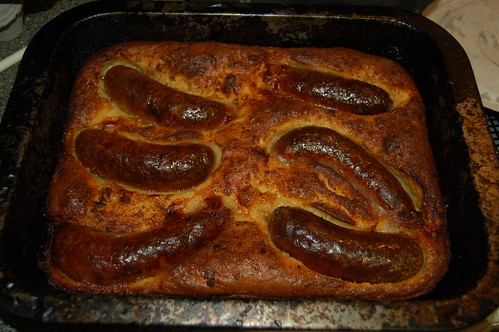
We had our first meal using meat from our Tamworth pig last night. 6 of the traditional pork sausages went in to a toad-in-the-hole. It was also an opportunity to use up one of our eggs to make the batter. We have a bit of a surplus at the moment. The milk and the flour that went into the batter was bought. I'm not sure we will be able to produce our own wheat for milling but there is a possibility we will be getting goats in the future, securing us a milk supply.
Anyway, I'm pleased to say that the sausages were fantastic.
Saturday 27 October 2012
Snow in October

As if the wet summer was not enough, now we have a snowy October. It started snowing last night, and this morning we woke to about 2cm of snow on the ground. In typically British fashion, it was enough to ground everything.
Never before have I known snow to be so soon. I'm writing this in the afternoon and fortunately, most of the snow has now gone. That, of course, has simply added to the mud on the allotment.
Tamworth pig - the meat has arrived
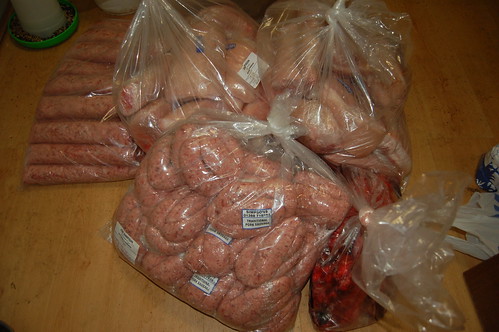
Yesterday I drove down to Cockfield in southern County Durham to pick up the meat from our Tamworth pig. I brought back a boot full of sausages, sausage meat, joints, trotters, offal, belly pork and cheek. I don't have the bacon yet. That will be ready for collection next week. The meat has to be cured first. That takes about 7-8 days.
Most of the meat went into the freezer when I got it back but we have kept out 2 joints and 2 bags of sausages. Tonight we will have toad-in-the-hole to use up the sausages. Tomorrow we will have one of the joints. The other joint and sausages will go to a friend who goes shooting. He will provide us with some game in return.
Our cat has been the first to sample the Tamworth. There was a sliver of meat attached to the liver which we boiled up for her. She scoffed the whole lot this morning. We got the lungs of the pig as well and that will be converted into cat food. The days of buying Whiskas are over.
Self-Sufficient in Suburbia: Early Autumn Edition
This is the latest edition of Self-Sufficient in Suburbia. After a miserable summer, autumn has arrived. The ducks are allowed to go free range, we got our first honey crop, the hens are producing lots of eggs but the tomatoes won't ripen so I end up making green tomato chutney. Meanwhile, I use rhubarb and blackberries to demonstrate the basics of jam making, use the autumn leek crop to make flans and soup and visited Bill Quay Community Farm to have a look at the pig we are planning to buy.
Wednesday 24 October 2012
How to make leek and potato soup
An autumn favourite of mine, leek and potato soup. The recipe is:
- chop 5 medium sized leeks, 4 medium potatoes and a large onion and add to a pan with a bit of oil. Cook gently for about 10 minutes.
- add a litre of stock and a couple of cloves of crushed garlic, bring to the boil and simmer for about 15 minutes.
- add half a litre of milk and simmer for a further 10-15 minutes.
How to make leek and bacon flans
Harvesting leeks is a sign that autumn has arrived. We picked all of ours last week as the ducks were starting to eat them. We have a number of leek recipes coming up and the first is leek and bacon flan:
- chop the leeks and put them in a pan with a bit of butter or oil and heat gently to allow them to sweat for about 20 minutes.
- chop the bacon and cook gently in its own fat for about 10 minutes.
- put short crust pastry into flan tins and put in the leek and bacon.
- beat sufficient eggs and pour over the leek and bacon.
- bake in the oven at 180C for about 20-25 minutes.
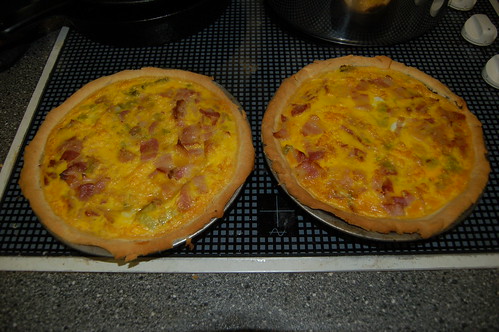
Tuesday 23 October 2012
Our Tamworth has gone to slaughter
Our Tamworth pig was send to the butchers today. I phoned them to make arrangements to collect the meat. I've drive down on Friday to collect the joints but the bacon will take longer. The meat needs to be cured and then sliced. It will be at least another week before we get the bacon.
We have bought an additional freezer but I have a nagging concern that we will be short of freezer space. The above video was filmed last week at Bill Quay Community Farm.
Letting the ducks go free range
It was time to let the ducks go free range. We had had them for a month and they had adapted well to the allotment. In the evening, they had learnt to put themselves to bed in the duck house. So on Sunday last week we decided it was time to dismantle the duck run and let the ducks go free range. Since then they have gradually explored the allotment but unlike the hens they've not gone onto the other plots.
There was only one minor confrontation between then hens and ducks. Garibaldi, one of our ginger nut rangers had a bit of a confrontation with the aylesbury. A bit of wing flapping and feathers standing up on the neck. It lasted all of 5 seconds.
How to make a duck egg sponge cake
With one of my ducks now laying an egg a day, I decided it was time to make a duck egg sponge cake. Here's the recipe I used:
- 6 duck eggs. Weigh them unbroken.
- Same weight of self-raising flour, butter and sugar as for eggs.
My confession is that the video only shows part of the story of making the cakes. In the end they turned out to be a bit of a disaster. The cakes sank in the middle because I had made them too thick. A bit of selective editing meant this disaster did not appear on video. However, watch out for the November edition of Self-Sufficient in Suburbia programme. The disaster will be there for all to see.

As you can see from this photo, the cakes have sagged in the middle.
Friday 19 October 2012
Our Tamworth pig

I went to Bill Quay Community Farm in Gateshead yesterday to have a look at the Tamworth pig we are going to buy from them. At this point in our plans to become self-sufficient, we are not in a position to keep a pig ourselves. To do that, we will need to have a bit more land. We are looking for some. However, before becoming a pig raising concern, we need to learn how to deal with a large quantity of pig meat. We have bought an additional freezer just to store meat. The pig itself (see picture above) goes to slaughter in about a week's time. After about 8 days, we get back the meat.
The animal will be fully butchered. Bacon joints will be sliced and some sausage meat will be turned into sausages. We have asked for some of the sausage meat to be left for us to turn into sausages ourselves. We are going to learn how to do curing and smoking ourselves. We will not be getting back the blood (making black pudding is something for the future) or the head but we will get back everything else, including the trotters.
Bill Quay Farm is a centre for breeding rare breeds and has an ethical policy towards the raising of livestock. That, plus the fact we do volunteer beekeeping there have attracted us to the idea of buying a pig from them.
We also have an offer from friends to swap pork for some of their lamb. They have a bit of land next to their house where they keep their sheep. We will definitely be taking up the offer!
So watch this space. There will be lots of pork and bacon recipes coming up.
Honey!
Sunday 14 October 2012
Free ranging
We took the decision some time ago to let our hens go free range on the allotment. We have a large chicken run but so many of the hens had become expert at getting out, but returning to the chicken run later that we decided our fears they would wander off and never be seen again were unfounded. Since then, they have learnt where all the gaps are in the hedge and now head off every day to wander around all the allotments in the area. The other allotment holders are happy with this at the moment. The hens provide entertainment and also get rid of bugs, slugs and snails. However, once people start planting crops, the hens will need to be confined to our own allotment as they will damage any plants. Nevertheless, anyone digging up a patch on an allotment often finds they are accompanied by a large number of hens which help them dig the patch as well. The bonus at the moment is that I am hardly having to feed the hens. They come back to the henhouses in the evening stuffed full.
Today we took the decision to let the ducks go free range. We have had them a month and they have settled in. We created a temporary duck run on the part of the allotment which turns to mud every time it rains. The run includes the pond. Today we removed the fencing so the ducks are now free to wander around the allotment. So off they wandered, always as a group of 7. They made a couple of visits to the apiary, walked past the manure heap and hung about next to the gate for a while. But their favourite site seems to be bed 3, next to the pond, and therefore next to where the duck run was. The bed still has a beetroot crop to pick but the ducks seem to like it as it catches the sun.
Meanwhile, we now have six duck eggs. I think only one duck is laying at the moment but at one egg a day, the description of the khaki campbells as "prolific layers" appears to be quite accurate.
Today we took the decision to let the ducks go free range. We have had them a month and they have settled in. We created a temporary duck run on the part of the allotment which turns to mud every time it rains. The run includes the pond. Today we removed the fencing so the ducks are now free to wander around the allotment. So off they wandered, always as a group of 7. They made a couple of visits to the apiary, walked past the manure heap and hung about next to the gate for a while. But their favourite site seems to be bed 3, next to the pond, and therefore next to where the duck run was. The bed still has a beetroot crop to pick but the ducks seem to like it as it catches the sun.
Meanwhile, we now have six duck eggs. I think only one duck is laying at the moment but at one egg a day, the description of the khaki campbells as "prolific layers" appears to be quite accurate.
Thursday 11 October 2012
How to make rhubarb and blackberry jam
I have never made rhubarb and blackberry jam before and I have never seen a recipe for it. I invented this one because I had some spare rhubarb, the blackberries are in season and I wanted to demonstrate the principles of jam making. Basically, you need pectin, sugar, acid and heat. That combination should mean your jam sets, subject to there being sufficient of each.
Anyway, this jam tasted rather pleasant.
Wednesday 10 October 2012
Food prices and supply
One of the main news stories today has been about the poor wheat harvest in Britain and how it will affect food prices in the shops. I know quite a number of Americans read this blog and extreme weather has hit the grain crop there as well. In the US, the problem has been the opposite to here in the UK. When I was in New York in March, the key news story was the heatwave which was damaging food crops. Back home, the persistent wet weather has been the problem. The result is the same: reduced yield. Russia, another major grain producing area, has suffered a damaging heatwave as well. Food prices will, as a result, go up and some shortages will result.
So what do we do in response? I don't want to have a long rant about the wasteful nature of modern western society and our propensity to eat too much food, and especially too much of the wrong types of food. Yet, if we could cut out food waste from our lives, people would, generally, save far more than would be spent on increased food prices. This seems an obvious solution but it is too often overlooked. I suspect most people have not sat down and worked out how much food is wasted in their own homes. Furthermore, many people shop in a way that is very wasteful. They arrive at the supermarket without a shopping list. Had they worked out in advance what they need, and then stick to the list, carefully ignoring the impulse buys, they would find the weekly shop costs much less and the amount they waste is reduced.
Meals need to be planned. Buy what you need (or better still grow at least some of it). Waste nothing. Regard leftovers not as bin fillers but as ingredients for the next meal. Planning and wasting nothing are two of the key principles for self-sufficiency. Living within our means is not just about money. It's about sustainable living and using our resources sparingly and to full effect. We need a sea change in society's attitude to the way we use our wealth and resources. Unwelcome price rises could be the jolt that makes people look at what we do with food, energy, waste and resources in a new light.
So what do we do in response? I don't want to have a long rant about the wasteful nature of modern western society and our propensity to eat too much food, and especially too much of the wrong types of food. Yet, if we could cut out food waste from our lives, people would, generally, save far more than would be spent on increased food prices. This seems an obvious solution but it is too often overlooked. I suspect most people have not sat down and worked out how much food is wasted in their own homes. Furthermore, many people shop in a way that is very wasteful. They arrive at the supermarket without a shopping list. Had they worked out in advance what they need, and then stick to the list, carefully ignoring the impulse buys, they would find the weekly shop costs much less and the amount they waste is reduced.
Meals need to be planned. Buy what you need (or better still grow at least some of it). Waste nothing. Regard leftovers not as bin fillers but as ingredients for the next meal. Planning and wasting nothing are two of the key principles for self-sufficiency. Living within our means is not just about money. It's about sustainable living and using our resources sparingly and to full effect. We need a sea change in society's attitude to the way we use our wealth and resources. Unwelcome price rises could be the jolt that makes people look at what we do with food, energy, waste and resources in a new light.
Our first honey crop
Lots of awful weather this year means that the bumper honey crop we were hoping for never happened. We had hoped to get honey in the late spring but all we got instead was swarms of bees. That at least meant we expanded from 2 hives at the start of June to 8 now. The good news on the honey front is that on Saturday we were able to take honey off one of our hives. There were only 5 frames but it's a start.
Green tomato chutney - the video
This is the video I shot of how to make green tomato chutney earleir this week. Since I first posted about this recipe, people have been in touch with ideas about other recipes to try. So watch this space, I'll have a couple of old American recipes I hope to try shortly.
Tuesday 9 October 2012
Our first duck egg
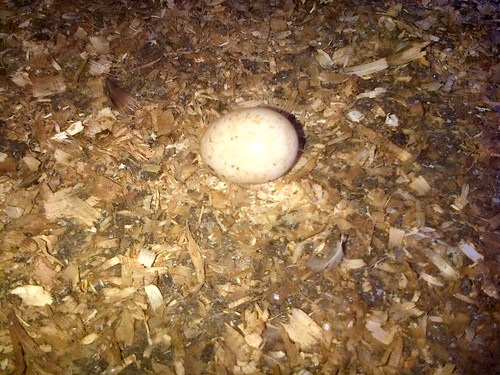
I opened the duck house this morning to find an egg. So one of our ducks has started laying. Excellent news. We have had them for nearly a month so hopefully the other adult will start laying soon as well.
Meanwhile, our ducklings are growing rapidly, though I have to report sadly that a couple of weeks ago, one of them (one of the aylesburies) died.
Monday 8 October 2012
Green tomato chutney recipe
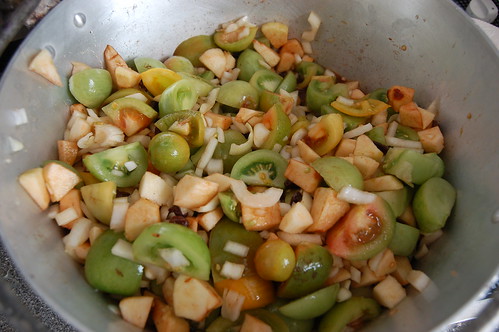
The miserable weather has knocked the tomato crop this year. I should have been harvesting lovely red tomatoes two months ago. Instead, I have a greenhouse full of green tomatoes at the start of October. They will not ripen so I will be picking them green. The same problem has affected people on neighbouring allotments. We have been engaged in a great deal of trading over the past few days. My eggs for their green tomatoes. I now have quite a green tomato mountain, and I haven't even started picking my own.
Today I used a bag of green tomatoes to make chutney. Here is my recipe.
Ingredients:
- 2kg green tomatoes, roughly chopped
- 900g chopped onions
- 900g chopped apples
- 100g raisins
- 4 cloves of garlic, crushed
- 450g soft brown sugar
- 2 teaspoons ground ginger
- 1 teaspoon ground cloves
- 1 teaspoon turmeric
- 600ml white wine vinegar
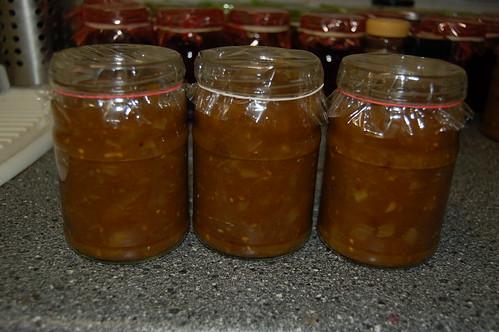
I filmed the making of this chutney so the video will be ready shortly. Meanwhile I'm looking around for interesting green tomato recipes. I found a very old one from America for green tomato mincemeat. I'll need to translate the measures but watch this space, I'll be making it shortly.
Friday 5 October 2012
A secret stash of eggs
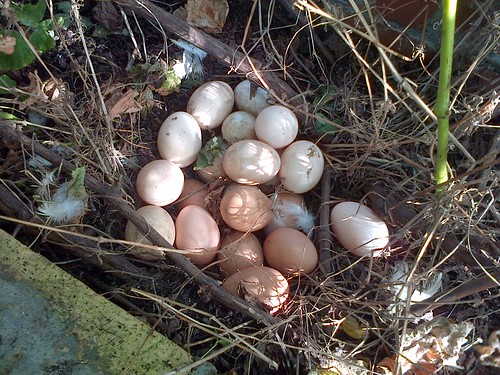
My hens have taken to wandering onto the neighbouring allotments. At this time of year, with little around for them to damage, they are causing no harm and the other allotment holders seem to enjoy having them as company and to help get rid of bugs, slugs and snails. Anyone who takes to digging up the ground however is likely to be mobbed by the hens as they race to beat each other to the worms.
Wandering off like this adds to a problem of laying out of the henhouse. The two boss hens, Snow White (a coral nick) and Atilla (a light sussex) seem to have an agreement to lay in the same place as each other, which is almost always away from the henhouse. When I know where they are laying, that is not a problem. Until about two weeks ago they were laying behind the hedge on the path leading to the allotment. And then suddenly they stopped laying there. Egg production figures were down overall in the absence of their eggs. Both are good layers, typically laying 9 out of 10 days on the trot.
I kept searching the hedgerows of the other allotments. Today I even checked under someone's shed. But there was no sign of eggs. And then Liz, on the neighbouring allotment, called through to tell me she had found where they were laying. There in her old greenhouse was a heap of 20 eggs, all but one laid by Snow White and Atilla. I gave Liz a dozen and took the other 8 back to my house to add to the egg mountain that has grown up in my absence. (I was away for 10 days last week doing some filming and photography in London and Brighton.)
I have been pickling eggs today but somehow, the number of eggs waiting to be used never seems to get smaller. I will be taking the eggs to a market a week tomorrow. In the meantime, I'll be currying them, pickling them, making egg custard, poaching them, swapping them, doing whatever I can with them.
Wednesday 3 October 2012
Picking sloes
The sloe crop where I live in the North East of England has failed, a result of our awful weather. The blossom was hammered by the heavy rain in May and the bees could not get out to pollinate the flowers that did survive the deluge. I was in London over the weekend and took a walk around Crystal Palace Park. And there I found a modest quantity of sloes. It is nothing like the abundance we had last year but it was enough to make it worthwhile picking them. Our apple crop has failed as well but a friend in London also gave me a bag of apples from a tree in his office garden. So, back home in the North East and I am now making sloe jelly. Alas, I won't have enough to add any to the hedgerow jelly I make each autumn. And there is certainly not enough to make sloe gin.
Monday 1 October 2012
Interviewing beekeepers
I went to the Harrogate Flower Show in September and when I was there I interviewed beekeepers for the Horticultural Channel. We discussed the impact of the weather on honey production and why the bees have swarmed so much this year.
Friday 28 September 2012
Self-Sufficinet in Suburbia - late summer
Here is the next edition of Self-Sufficient in Suburbia. It is late summer and we take a look at how the weather has affected the wild food foraging crops and try out an historic recipe for rosehip syrup. I also head to the Bowes Agricultural Show to enter the jam and eggs competition. And finally, our ducks arrive, making the most of the pond we dug last year.
Thursday 27 September 2012
The Wartime Farm
I was recently sent a review copy of "The Wartime Farm", a book to accompany the BBC series of the same name, by the publishers Octopus Books. Last year, wearing both my historian's and horticulturalist's hats, I spent 2 weeks living on a wartime diet. I made a series of videos about it and the local media took quite a bit of interest in what I did. It seems Octopus Publishing noticed it as well. So when they asked me if I wanted a copy of the book, I replied that I would love to receive one and review it for them. After all, I am a great fan of the previous programmes they have produced about farming in the Stuart, Victorian and Edwardian periods. The Wartime Farm itself is currently being broadcast on Thursday evenings on BBC2. After locking up my hen and duck houses and watering the greenhouse, my Thursday evenings are now spent watching the tv.
I've just finished reading the book. I loved it. The big joke in our house is that when we are watching a history programme, I will predict what is about to be said and, assuming I get it right (not always the case!) I end up saying, "I could have written it for them!" Whilst this can be applied to some of the history behind the Wartime Farm programme and book, there is plenty that is new to me. Farming and food production during the war years is something about which we as a nation have a vague collective consciousness but it is an area that is not extensively researched. There is much to be learnt and, frankly, the lessons of the war years can be applied to the modern world. Problems of poor diet, over-consumption of calories by some, under-consumption by others, waste, land use, health were all tackled successfully in the war years. Sadly, the UK as a whole has, for decades now, been forgetting much of what was learnt in the war years with terrible consequences: obesity in some, unhealthy lifestyles and lack of exercise, bad diets, to name but a few.
The book and the series covers a range of issues, not all directly to do with food. One of the most interesting was the revival of old skills that were dying out as the war began. For example, blacksmiths came out of retirement to help repair old farm machinery that had been left to rust for years in the corner of fields. Alex Langlands revived the art of making bee skeps. As a beekeeper myself, I found this fascinating. He even created the materials himself from straw available on the farm and from brambles.
"Make do and mend" is a familiar catchphrase from the war years. Its meaning is now something that is lost on modern Britain. There is a tendency now to throw something out if it is broken, rather than repair it for continued use. Indeed, some things are thrown out now that have years of life left in them. Look at the way clothes are bought and disposed of nowadays. The number of people who make their own clothes is, sadly, diminishing. I fear that we will lose those skills forever. Clothes are often thrown away because they are no longer fashionable. Such utter waste is killing the planet and would have been viewed with complete horror in the war years. Typically a person now would buy more clothes in a fashion season than someone living 70 years would have bought across the whole of the 14 years they had ration books. Then people knew how to make things last, how to reuse something, how to repair, how to get the best from something, how to make it into something else.
One of the unsung heros of the war was the Women's Institute. The book examines the tremendous voluntary work the WI put in during the war years to increase the country's food supply. Not only did they turn Britain's bounty of wild foods into the jams and preserves that are always associated with them, they also turned themselves into a mobile university and training organisation, teaching others the skills needed to preserve food and increase the food supply. In the war on the home front, they were the cavalry, charging in to do the job. Sadly, too many people now think of the WI as a small "c" conservative organisation, full of "Little Britain" ladies whose stomachs turn when confronted with people who do not follow a preconceived norm. The reality is totally different. The WI helped us get through the war. The book brings that out superbly.
Now that I have a copy of "The Wartime Farm", it is no longer on my Christmas present list. (The book has a section on making toys so if anyone wants to make me the Spitfire Alex Langlands made from tin cans, you know what to pop in my stocking this December.) The book however is a great read, even if you have no interest in history. So forget about asking for more clothes that will be unwearably unfashionable by this time next year. Get a copy of this book for Christmas (or even earlier) instead.
"The Wartime Farm" is published by Octopus Books, price £20.
I've just finished reading the book. I loved it. The big joke in our house is that when we are watching a history programme, I will predict what is about to be said and, assuming I get it right (not always the case!) I end up saying, "I could have written it for them!" Whilst this can be applied to some of the history behind the Wartime Farm programme and book, there is plenty that is new to me. Farming and food production during the war years is something about which we as a nation have a vague collective consciousness but it is an area that is not extensively researched. There is much to be learnt and, frankly, the lessons of the war years can be applied to the modern world. Problems of poor diet, over-consumption of calories by some, under-consumption by others, waste, land use, health were all tackled successfully in the war years. Sadly, the UK as a whole has, for decades now, been forgetting much of what was learnt in the war years with terrible consequences: obesity in some, unhealthy lifestyles and lack of exercise, bad diets, to name but a few.
The book and the series covers a range of issues, not all directly to do with food. One of the most interesting was the revival of old skills that were dying out as the war began. For example, blacksmiths came out of retirement to help repair old farm machinery that had been left to rust for years in the corner of fields. Alex Langlands revived the art of making bee skeps. As a beekeeper myself, I found this fascinating. He even created the materials himself from straw available on the farm and from brambles.
"Make do and mend" is a familiar catchphrase from the war years. Its meaning is now something that is lost on modern Britain. There is a tendency now to throw something out if it is broken, rather than repair it for continued use. Indeed, some things are thrown out now that have years of life left in them. Look at the way clothes are bought and disposed of nowadays. The number of people who make their own clothes is, sadly, diminishing. I fear that we will lose those skills forever. Clothes are often thrown away because they are no longer fashionable. Such utter waste is killing the planet and would have been viewed with complete horror in the war years. Typically a person now would buy more clothes in a fashion season than someone living 70 years would have bought across the whole of the 14 years they had ration books. Then people knew how to make things last, how to reuse something, how to repair, how to get the best from something, how to make it into something else.
One of the unsung heros of the war was the Women's Institute. The book examines the tremendous voluntary work the WI put in during the war years to increase the country's food supply. Not only did they turn Britain's bounty of wild foods into the jams and preserves that are always associated with them, they also turned themselves into a mobile university and training organisation, teaching others the skills needed to preserve food and increase the food supply. In the war on the home front, they were the cavalry, charging in to do the job. Sadly, too many people now think of the WI as a small "c" conservative organisation, full of "Little Britain" ladies whose stomachs turn when confronted with people who do not follow a preconceived norm. The reality is totally different. The WI helped us get through the war. The book brings that out superbly.
Now that I have a copy of "The Wartime Farm", it is no longer on my Christmas present list. (The book has a section on making toys so if anyone wants to make me the Spitfire Alex Langlands made from tin cans, you know what to pop in my stocking this December.) The book however is a great read, even if you have no interest in history. So forget about asking for more clothes that will be unwearably unfashionable by this time next year. Get a copy of this book for Christmas (or even earlier) instead.
"The Wartime Farm" is published by Octopus Books, price £20.
The Horticultural Channel at Harrogate
I visited the Harrogate Flower Show earlier this month and met up with Sean Cameron, producer of the Horticultural Channel for which I was a presented last year. I was also introduced to Jamie Butterworth, BBC Young Gardener of the Year finalist. I interviewed the beekeepers at the show and talked to them about how the weather has hit honey production.
Tuesday 18 September 2012
Ducks doing well
Our new ducks and ducklings are doing well. They appear to have settled in to the duck run and have been making full use of our pond. They have eaten most of the duck weed on it though they have also started to eat the watercress. We may move some of the watercress into a barrel pond we have in our back garden. Getting the ducks into the duck house tonight was much easier than last night. No wild duck chases tonight to catch duckings small enough to get through the wire netting. Instead, I funnelled them all into the duck house without any bother. They remain very nervous of people but I think in time they will get used to us, especially when they learn that we are a source of food for them.
Bee hive recovery
I have written recently that we thought one of our hives had become queenless. Our plan was to merge it with another but an inspection of it was needed before merging it to ensure there were no workers in the hive laying their own eggs. Such eggs will give rise to drones but not workers. They can be spotted as an irregular pattern of dome shaped capped comb. An egg laying worker thinks it is a queen and if it is in a hive that is being merged with another, there is a strong chance it could kill the queen in the other hive. That would leave the merged colony to die gradually.
Today I checked the hive we thought was queenless to look for the signs of an egg laying worker. I had a rather pleasant surprise. There was brood in the hive and no sign of any laying workers. It means this hive is recovering. We had a large swarm at the start of August (very late in the year for swarming) and we think this hive was the one that produced it. The swarm would have taken with it the existing queen. When we last checked the hive about 3 weeks ago, there was no brood. Our conclusion was that the queen had been killed whilst out being mated. It seems we were wrong. The queen had returned to the hive. We must have checked it right at the point when the new queen had not started laying.
The other bit of good news is that the super on this hive had 4 full frames of capped honey. We may just be able to get a very small honey crop after all.
Today I checked the hive we thought was queenless to look for the signs of an egg laying worker. I had a rather pleasant surprise. There was brood in the hive and no sign of any laying workers. It means this hive is recovering. We had a large swarm at the start of August (very late in the year for swarming) and we think this hive was the one that produced it. The swarm would have taken with it the existing queen. When we last checked the hive about 3 weeks ago, there was no brood. Our conclusion was that the queen had been killed whilst out being mated. It seems we were wrong. The queen had returned to the hive. We must have checked it right at the point when the new queen had not started laying.
The other bit of good news is that the super on this hive had 4 full frames of capped honey. We may just be able to get a very small honey crop after all.
Sunday 16 September 2012
Bowes Agricultural Show - photos
I went to the Bowes Agricultural Show in Co Durham on Saturday 8th September. As well as winning the jar of jelly and the eggs competition, I also spent some time taking photos around the show. Here are a few of them>

Sheep judging competition
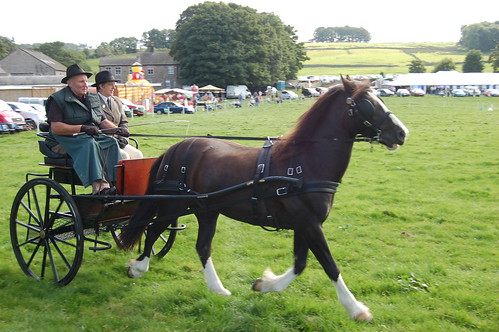
Modern transport

Time to take the cow for a walk
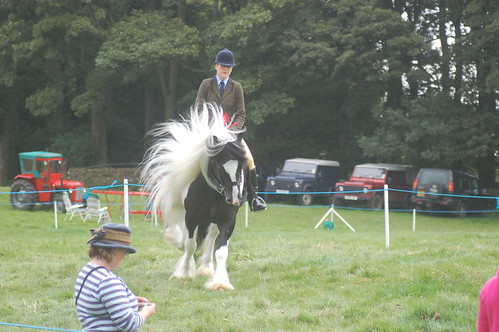
Time for a haircut
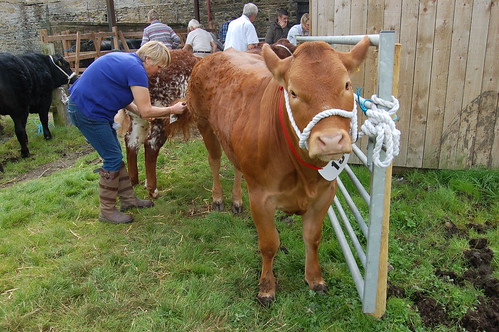
Cut and blow dry

Sheep judging competition

Modern transport

Time to take the cow for a walk

Time for a haircut

Cut and blow dry
North East Horticultural Society Championship Show
Ducks
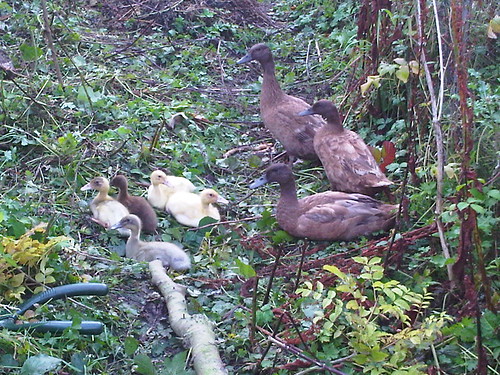
I am desperately trying to avoid puns such as going quackers, hello duckie and so on but today we bought our first ducks. It was a bit of a rushed affair. We had previously planned to get ducks but when we searched around for a supplier, we drew a blank. We then decided to put the plans on hold for a few months and then approach the whole issue from a different angle - we would buy an incubator and order fertilised duck eggs over the internet. The incubator could also be used for rearing quails and possibly turkeys as well.
This afternoon, we headed to the South Causey Inn, about 4km up the road from where we live, to go to the North East Horticultural Society Championship Show, run in conjunction with the National Pot Leek Society Show. We weren't entering any competitions. We simply went along to have a quick look at the enormous vegetables. When we got there we found there was also a poultry show and when we looked around, we discovered ducks for sale. Three point of lay khaki campbells were looking for a new owner and they were competitively prices, compared to what we would expect to pay for hens. So we decided to buy them but had to rush off to get cash and sort out a duck house.
We phoned Durham Hens, from whom we have bought most of our hen supplies and they said that one of their hen houses was suitable as a duck house as well. So we headed over, bought it and on the way back, returned to the South Causey Inn to get the three ducks. There, the seller persuaded us to buy the 5 ducklings in the next cage as well. For £3 each, we thought they were worth the price.They consist of one khaki campbell, 2 aylesbury, one runner and one magpie. I don't know what sex they are but we will find out soon. The adult khaki campbells are one drake and 2 ducks.
Back to the allotment and we put the duck house together and then fenced off the area of the allotment we had already planned for the duck run. It contains the pond. The hens won't approve that the pond has been fenced off. They drink from the pond and also have a taste for duckweed. Much of the area we have fenced off cannot be used to grow crops. It floods when it rains. When we first got the allotment, we tried to grow potatoes there. They all rotted in the ground. The land we have put aside for the duck run therefore is not a loss for our vegetable growing activities. The run however will be temporary. Once the ducks have become established, we will remove the fencing and let them roam free over the allotment.
When we put the ducks into the duck house, they immediately headed off into the duck run. The ducklings stayed with the adults constantly. Whether they like it or not, they have become adoptive parents. I hung around a bit to see if they would use the pond but they all seemed to settle down on the ground (see above photo) so I left them to it. I returned an hour later to encourage them to go into the duck house. It was clear at that point that they had been using the pond. Much of the duckweed had gone.
Getting them into the duck house was something of a challenge. The adults were no bother. They went straight in. The ducklings however scattered to the winds. 2 were small enough to get through the wire netting of the fence. We had an interesting time rounding them up in the semi-darkness. We eventually got them all in. Let's hope we don't have to repeat that exercise!
Wednesday 12 September 2012
Making rosehip syrup
I used a wartime recipe to make rosehip syrup recently. The rosehip foraging crop is not too bad and they are a good source of vitamin C for us. 14 bottles made. We'll swap some for other people's produce. The rest we will put on pancakes, drizzled on cakes or used to make a cocktail.
Tuesday 11 September 2012
Trade and swaps
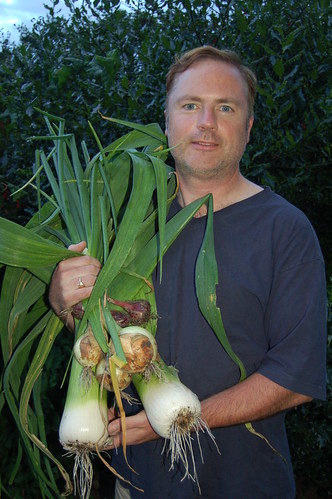
Call it trade or swaps, it's effectively the same thing in the world of self-sufficiency. One of the things I found early on in my attempts to become self-sufficient is that when I have a surplus of one type of produce, there are often others who are keen to swap their surplus with me. We are unlikely to produce all our own food ourselves but other allotment gardeners are likely to be producing something we ourselves have not grown. And visa versa. Eggs and jam act as a sort of self-sufficiency local currency.
So tonight, I swapped 10 eggs and a jar of lemon curd for two enormous leeks and a bunch of onions with one of the neighbouring allotment holders (see photo above). Our own leeks are still growing but our onions have now all been picked and they were not overly impressive. They are rather small so I am going to pickle them instead. Last week I swapped 6 eggs for a pile of rhubarb with one allotment gardener and a jar of lemon curd for some beetroot from another. Eggs for us are not in short supply. Today we had 12 from the hens, a record for us. One of our older hens stopped laying 6 weeks ago but yesterday started laying again. So egg production is going well and that creates a useful currency for us.
Monday 10 September 2012
Bowes Show
If you are a regular visitor to this blog you may already be aware that I went to the Bowes Agricultural Show on Saturday and we won prizes for our eggs, rowan jelly and blackberry jam. This is the video I filmed at the show.
Sunday 9 September 2012
Foraging news
We carried out an inspection of the local wild food sources last week. It is a mixed picture. Hazel and rosehips are doing well, hawberries, elderberries and blackberries are doing okay, acorns, apples and sloes have failed. The video was filmed during the inspection and I go into a few details about how the extreme weather we have had this year has affected wild foraging crops.
Pickling eggs
When we have more eggs than we can realistically expect to consume, we pickle them. I made another jar of them last week. This is the video on how to pickle eggs. We use the smaller eggs laid by our hens for pickling.
Winning at the Bowes Show
Yesterday's trip to the Bowes Agricultural Show turned out to be something of a success. Firstly the sun shone all day. Secondly, I had a good time and thirdly, I came first in two of the competitions I entered and 2nd in another.
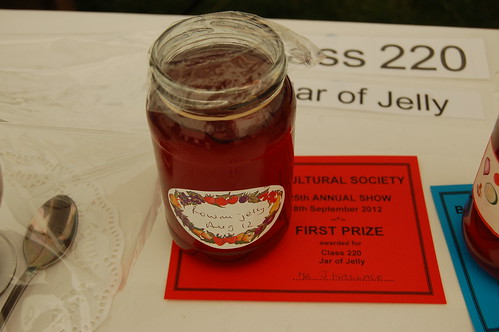
This is my rowan jelly which got first prize in the jar of jelly section of the jams and preserves.

The 4 eggs were laid by one of my new hens, one of the columbines. The eggs are an olive green colour. They got first prize in the 4 eggs competition.

The blackberry jam I made on Friday was entered for the "any jam other than raspberry" competition and came second.
We didn't win anything on the chutney, raspberry jam or lemon curd competitions. Having looked around the industrial and produce marquee, I regretted not going in for the baking competitions. Given the poor state of my crops, I was probably wise not to enter the produce competitions but I am inspired to enter next year. And the baking competitions are also likely to see Wallace entries in the future as well.

This is my rowan jelly which got first prize in the jar of jelly section of the jams and preserves.

The 4 eggs were laid by one of my new hens, one of the columbines. The eggs are an olive green colour. They got first prize in the 4 eggs competition.

The blackberry jam I made on Friday was entered for the "any jam other than raspberry" competition and came second.
We didn't win anything on the chutney, raspberry jam or lemon curd competitions. Having looked around the industrial and produce marquee, I regretted not going in for the baking competitions. Given the poor state of my crops, I was probably wise not to enter the produce competitions but I am inspired to enter next year. And the baking competitions are also likely to see Wallace entries in the future as well.
Friday 7 September 2012
2.5 million viewings
Thanks to everyone who has viewed my videos on my YouTube channel (www.youtube.com/jonathanwallace). The good news is that the viewing figures have now reached 2.5 million. Though I also include my travel videos and occasional others, the drivers that are pushing up the viewing figures are those dealing with cooking and gardening. There are over 700 videos on the channel. My oldest cookery video is (I think) about how to make raspberry jam. The most popular cookery video is currently "How to dry tomatoes", picking up over 7,000 viewings a month. For the record, my most viewed video has nothing to do with my self-sufficiency activities. It is "Former Soviet Secret Submarine Base", filmed in Balaklava in the Crimea in the Ukraine in 2006. It has nearly a quarter of a million viewings.
There are two videos already edited waiting to go up: "How to pickle eggs" and "Foraging news August 2012". Waiting to be filmed are "How to make horseradish sauce", "How to make Yorkshire pudding" and "How to make panhaggaty". I will also be filming at the Bowes Show tomorrow and at the Harrogate Show next Friday. So there's plenty more coming up.
There are two videos already edited waiting to go up: "How to pickle eggs" and "Foraging news August 2012". Waiting to be filmed are "How to make horseradish sauce", "How to make Yorkshire pudding" and "How to make panhaggaty". I will also be filming at the Bowes Show tomorrow and at the Harrogate Show next Friday. So there's plenty more coming up.
Getting ready for the Bowes Show
Tomorrow, 8th September, I will be going to the Bowes Agricultural Show in Co Durham. And for the first time I will be entering a jam-making competition. Actually, technically it will be the second time. Last year, I was invited to enter the Whickham Air Training Corp Annual Garden Party jam making competition, which I won. There were however only 4 entries and 2 of them were from me! So I don't really count it as it wasn't a battleground between seasoned prize-winning jam makers. Tomorrow I will be up against some serious competition and as a novice in these competitions, I enter the race with a significant handicap.
Anyway, I am going in for the raspberry jam, lemon curd, jelly, non-raspberry jam and chutney sections and the egg section (4 eggs are required for this). I am taking 4 of our green eggs laid by our columbines. The first prize is a mere £3. The real prize is the prestige of coming out top. Hopefully there will be rosettes or certificates for the winners to show off. I doubt I will win anything on a first attempt but it will be fun nonetheless.
More information about the show can be found at http://www.bowesshow.org.uk/
Anyway, I am going in for the raspberry jam, lemon curd, jelly, non-raspberry jam and chutney sections and the egg section (4 eggs are required for this). I am taking 4 of our green eggs laid by our columbines. The first prize is a mere £3. The real prize is the prestige of coming out top. Hopefully there will be rosettes or certificates for the winners to show off. I doubt I will win anything on a first attempt but it will be fun nonetheless.
More information about the show can be found at http://www.bowesshow.org.uk/
Thursday 6 September 2012
How to make mint sauce
We have lots of mint growing on Dad's allotment so we have used some of it to make mint sauce. Start by stripping the leaves from the stalks and then chop them. Put the chopped leaves in a bowl and mix in a small amount of sugar. Leave to stand for an hour and then add white wine or cider vinegar and sugar to taste. Mix thoroughly and store in jars. Leave for about a week before using.
The dangers of queenless hives
We have been having a bit of correspondence with someone whose two hives have both become queenless. We have copied in a beekeeper friend, Mark, whose expertise is well in advance of ours. The discussion is important to us as we too have found that one of our eight hives has become queenless. We are planning to merge this hive with another. Mark has advised that it needs to be done as soon as possible. A queenless colony can see some worker bees start laying. These bees are infertile but when a fertile queen is added to the colony, the infertile fake queens can end up killing the new one. Clearly this is something we want to avoid. We don't want rogue bees killing the queen of the hive to which they have been added. It means we will have to do the hive merger in the next couple of days.
Tuesday 4 September 2012
Self-Sufficient in Suburbia - July edition
This is the latest edition of our Self-Sufficient in Suburbia videos. It covers July. Bad weather has knocked back some of our crops but the jam making season has begun. Meanwhile the hens have started moulting. Elderflower is late and I use it to make cordial and drop scones.
Monday 3 September 2012
Sunny days ahead
At last, the weather forecast announces a sunny week ahead. And we need it as well! Firstly, I need the ground to dry out so I can dig up the rest of the potatoes. Secondly, I need some sun to ripen the tomatoes in the greenhouse. Thirdly, I need some sun to ripen the blackberries. Fourthly, I just need some sone as I'm fed up with the rotten weather!
Anyway, coming up today: I'm pickling eggs and making a blackberry pie, horseradish sauce and rosehip syrup. I also swapped a jar of lemon curd and six eggs for a pile of rhubarb yesterday so I may be making rhubarb and ginger jam soon.
Anyway, coming up today: I'm pickling eggs and making a blackberry pie, horseradish sauce and rosehip syrup. I also swapped a jar of lemon curd and six eggs for a pile of rhubarb yesterday so I may be making rhubarb and ginger jam soon.
Sunday 2 September 2012
Hive check
We carried out a full hive check today. All 8 were checked thoroughly. It seems we have another queenless hive. We had a very large swarm at the start of August and we think the result of that is that the colony left behind was weaker than it should be. Somehow, the virgin queen that should have been left with the colony was disappeared. We will need to merge this weaker colony with a stronger one. We have not yet decided which. Interestingly, the late swarm has taken well to its new hive. The queen is working well - there was brood in this new hive - and there was lots of activity from the bees.
We have three hives that are a mess because of wildcomb. We made the mistake of giving these hives fondant when they were set up at the end of June. The effect of this was to create a large space at the top of the hive which the bees have now filled with comb, attached to the crownboard. Solving this is not going to be easy and we are thinking that the best solution is to let the bees simply get on with it and next year we'll add a queen excluder and supers to collect honey. It will also mean that doing proper inspections of these hives is going to be next to impossible in the future.
Nevertheless, all the new hives were strong and active.
We have three hives that are a mess because of wildcomb. We made the mistake of giving these hives fondant when they were set up at the end of June. The effect of this was to create a large space at the top of the hive which the bees have now filled with comb, attached to the crownboard. Solving this is not going to be easy and we are thinking that the best solution is to let the bees simply get on with it and next year we'll add a queen excluder and supers to collect honey. It will also mean that doing proper inspections of these hives is going to be next to impossible in the future.
Nevertheless, all the new hives were strong and active.
Friday 31 August 2012
A cold chill
Yesterday was cold. I had to dress in warm clothes when I went down to the allotment. The bees were very quiet, staying in the hive rather than venturing out to forage. I was concerned about the new hive we set up as a result of an unexpected swarm at the start of this month. It would not have had time to build up a store of honey and if the bees weren't getting out to collect nectar, there was a serious chance the colony could starve. We had fed it a bucket of sugar syrup when we set up the hive three weeks ago but the chances were that the bees would have drained it. So I prepared a new bucket of syrup and we took it down to Apiary 2. Sure enough, the bees had finished the first bucket of syrup. My guess is that they will get through the new one in just a few days. The weather forecast for Sunday is looking better so we will do a full hive inspection then.
We didn't need official government agencies to tell us that the summer, which for statistical purposes ends today, was the wettest for one hundred years. Nevertheless, we were told the news yesterday that we already knew. The rotten weather has sent a cold chill through food production. We have felt it first hand. No honey crop so far and my hopes of getting even a small one within the next few weeks are fading fast. No apple crop. No sloes. Root crops are poor. Bizarrely the runner beans are doing very well.
The blackberries are late this year. Yesterday I went on a blackberry forage, hoping to gather enough to make some blackberry jam. I managed to pick enough to make a pie. The jam is on hold until more blackberries have ripened.
We didn't need official government agencies to tell us that the summer, which for statistical purposes ends today, was the wettest for one hundred years. Nevertheless, we were told the news yesterday that we already knew. The rotten weather has sent a cold chill through food production. We have felt it first hand. No honey crop so far and my hopes of getting even a small one within the next few weeks are fading fast. No apple crop. No sloes. Root crops are poor. Bizarrely the runner beans are doing very well.
The blackberries are late this year. Yesterday I went on a blackberry forage, hoping to gather enough to make some blackberry jam. I managed to pick enough to make a pie. The jam is on hold until more blackberries have ripened.
Wednesday 29 August 2012
And then there were 10
Subscribe to:
Posts (Atom)


